Bees
There are over 250 species of bee in Britain, mostly solitary bees, the more familiar bumblebees and various cuckoo bee species; a total of 53 species have been discovered in the Dawlish Warren Recording Area. It is anticipated that more species will be added in coming years. The peak time is between May and August when over 20 species can be found without difficulty. It is hoped that the following information will help in finding and recording bees on site. Please submit any sightings to the Recording Group and/or Devon Biodiversity Records Centre.
Some solitary bees especially cannot be identified with certainty without taking a specimen for examination, Teignbridge Council have unfortunately refused permission for the Recording Group to take specimens. The majority of these species have therefore been identified in the field or by using digital photography, some have however been confirmed from specimens taken by visiting entomologists.
Further information on identification and status can be found in Field Guide to the Bees of Great Britain and Ireland (Falk & Lewington, 2015).
Summary and photos by Recording Group member Alan Keatley.
Related links: Bees, Wasps & Ants Recording Society Steven Falk Flickr collection
Last update 15 May 2021.
Species
Colletes fodiens
Hairy-saddled Colletes
Found at only a handful of Devon sites
this late summer species favours Ragwort, as a consequence of ongoing Ragwort
pulling it has become
much scarcer on site, only remaining in numbers on Warren Point.
Colletes hederae
Ivy Bee
First recorded in 2008, this species is
now widespread on site, emerging with the flowering Ivy late summer.
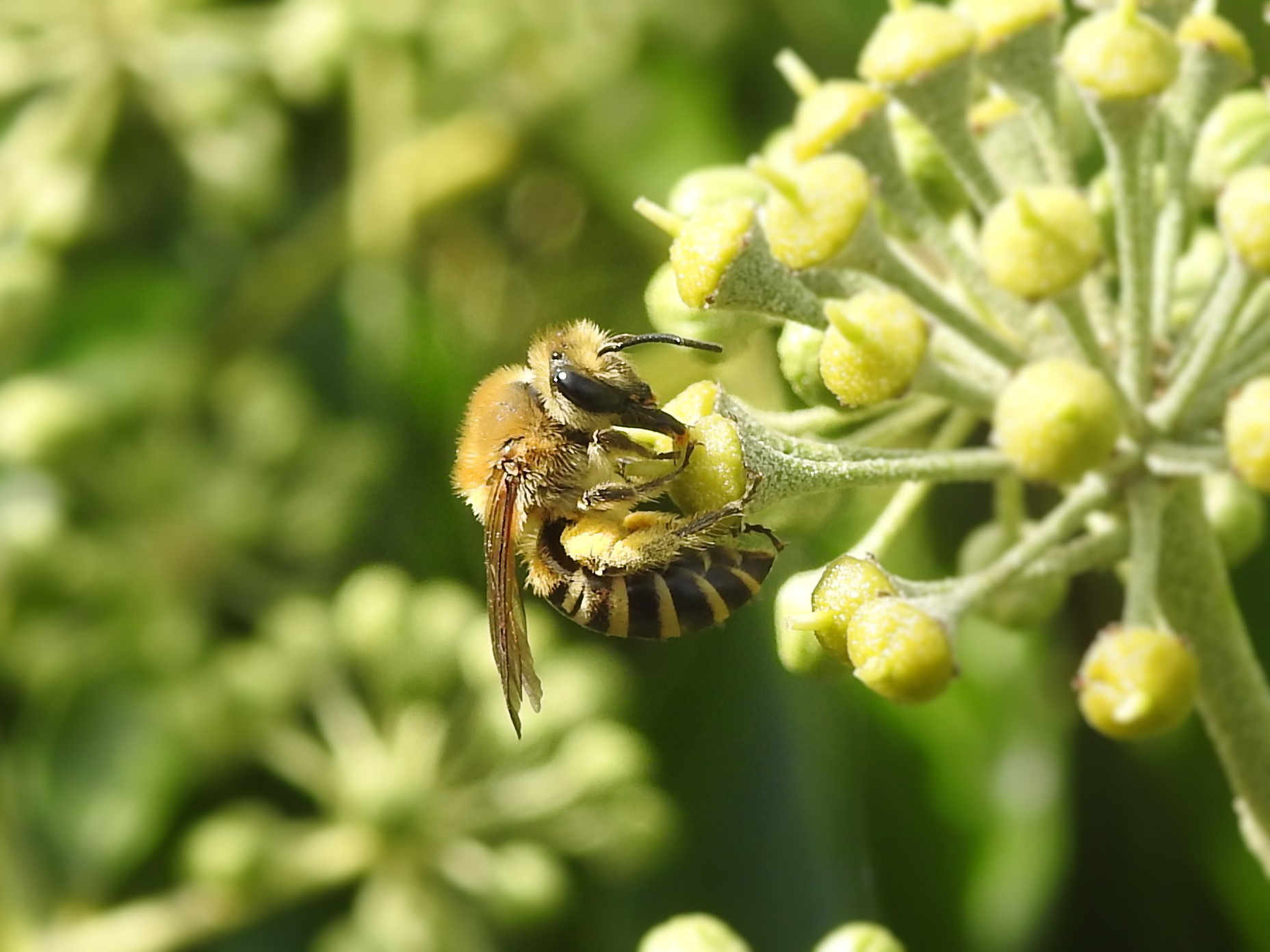
© Alan Keatley
Colletes similis
Bare-saddled Colletes
Flight season from mid June to mid September, earlier than Hairy-saddled
Colletes and two months earlier than Ivy Bee. Shares the same flowery habitat,
but less associated with sandy soils than Hairy-saddled Colletes. Common in and
rounded Greenland Lake.
© Alan Keatley
Andrena ampla
Water-dropwort Mining Bee
A Nationally Scarce species first recorded in 2018, this species is largely
confined to SW England and is strongly associated with Hemlock Water-dropwort.
© Alan Keatley
Andrena
barbilabris
Sandpit Mining Bee
Widespread across the site, this species
favours areas of loose sand largely ignored by other species.
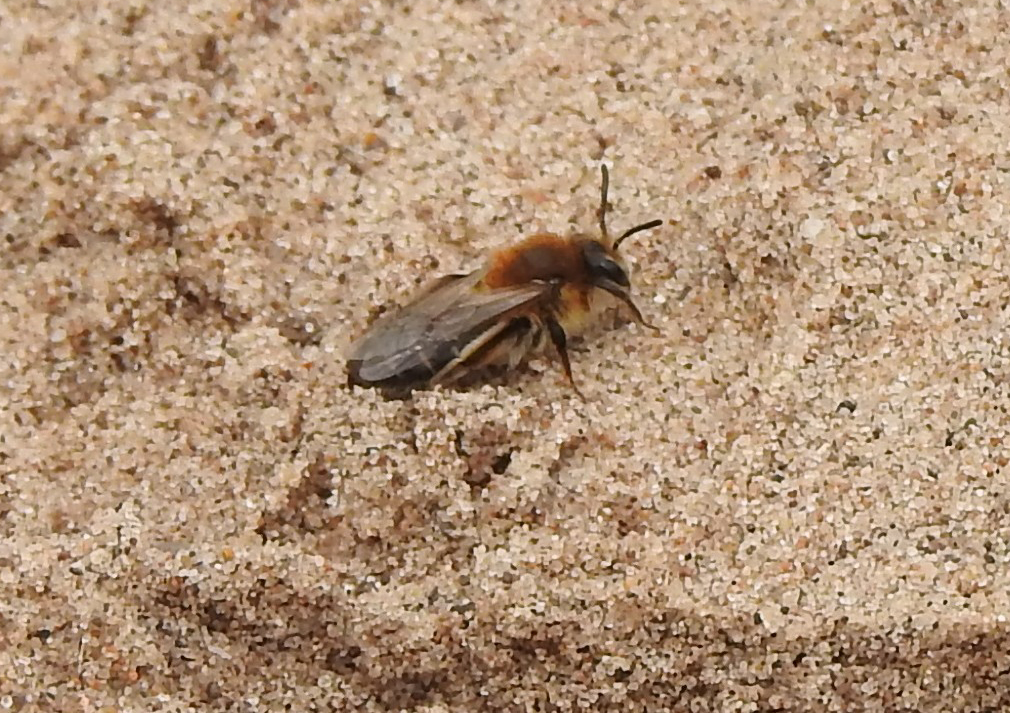
female/male © Alan Keatley
Andrena bicolor
Gwynne's Mining Bee
A bivoltine species (two generations a year), the early spring
population often seen on flowering sallows.
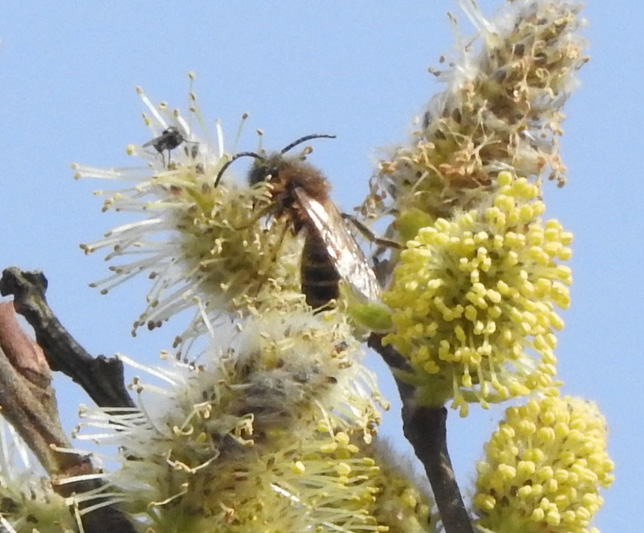
© Alan Keatley
Andrena cineraria
Ashy Mining Bee
A widespread spring species first
recorded here in 2018.
© Alan Keatley
Andrena dorsata
Short-fringed Mining Bee
Another bivoltine species, the spring
generation favouring sallows and blackthorn, the summer utilising bramble.
Andrena flavipes
Yellow-legged Mining Bee
Bivoltine, the spring generation uses flowering shrubs but also Alexanders. The
summer generation can be found on other umbellifers such as Water dropwort.
There is a large colony on the car park roundabout.
© Alan Keatley
Andrena haemorrhoa
Orange-tailed Mining Bee
Another species that depends on flowering shrubs early in the year.
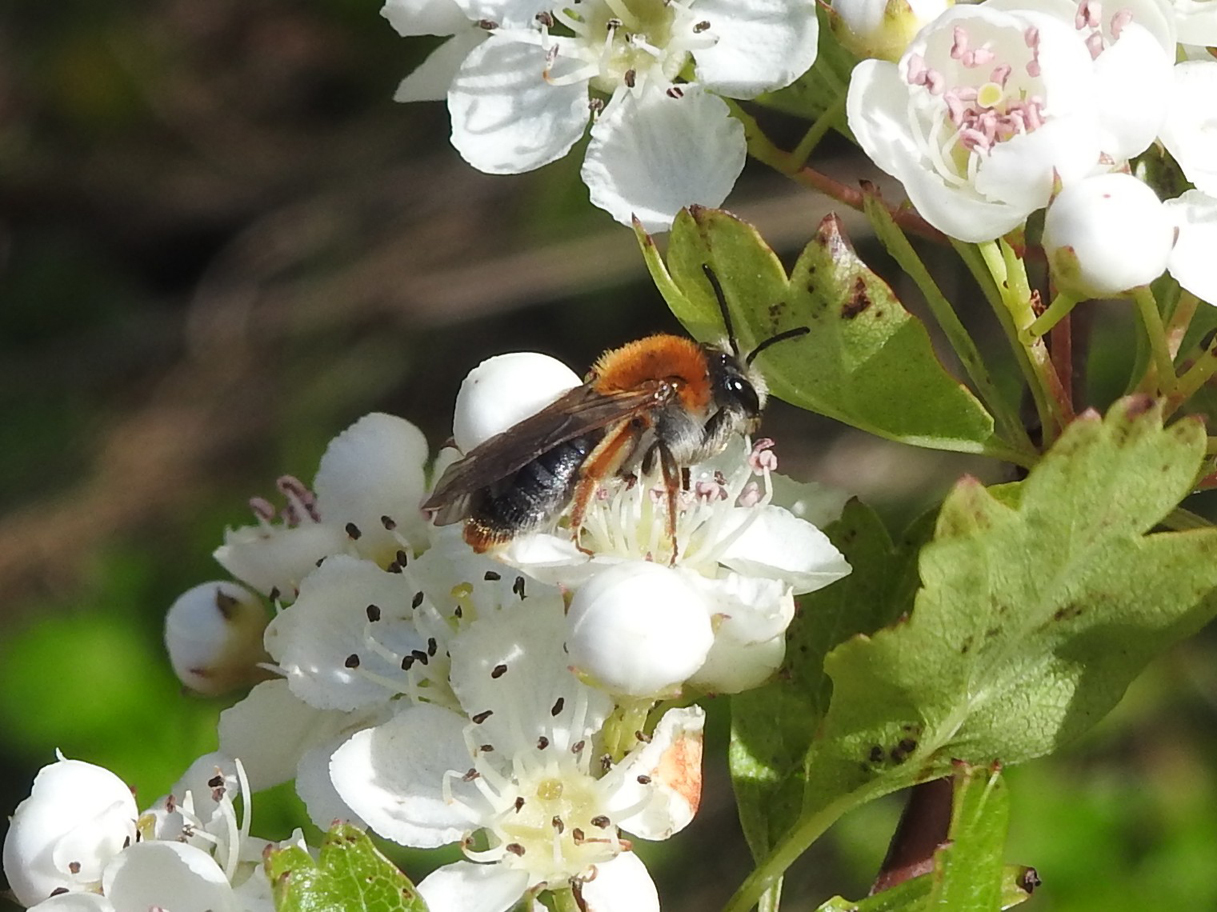
© Alan Keatley
Andrena humilis
Buff-tailed Mining Bee
Nationally Scarce B. Also known at the Cat's-ear mining Bee as it forages
exclusively on yellow-flowered composites such as hawkweeds and cat's-ears. Loss
of rabbits and increased summer mowing are likely factors in the lack of records
since 2010.
Andrena labiata
Red-girdled Mining Bee
A Nationally Scarce A species first recorded in 2018.
© Alan Keatley
Andrena minutula
Common Mini-miner
The commonest of the mini-miners, with
two generations. Found in various habitats and can be encountered anywhere on
site on shrubs and flowers in small numbers. Spring males have black haired
faces and Summer males white.
© Alan Keatley
Andrena nigroaenea
Buffish Mining Bee
Often one of the commonest species on site.
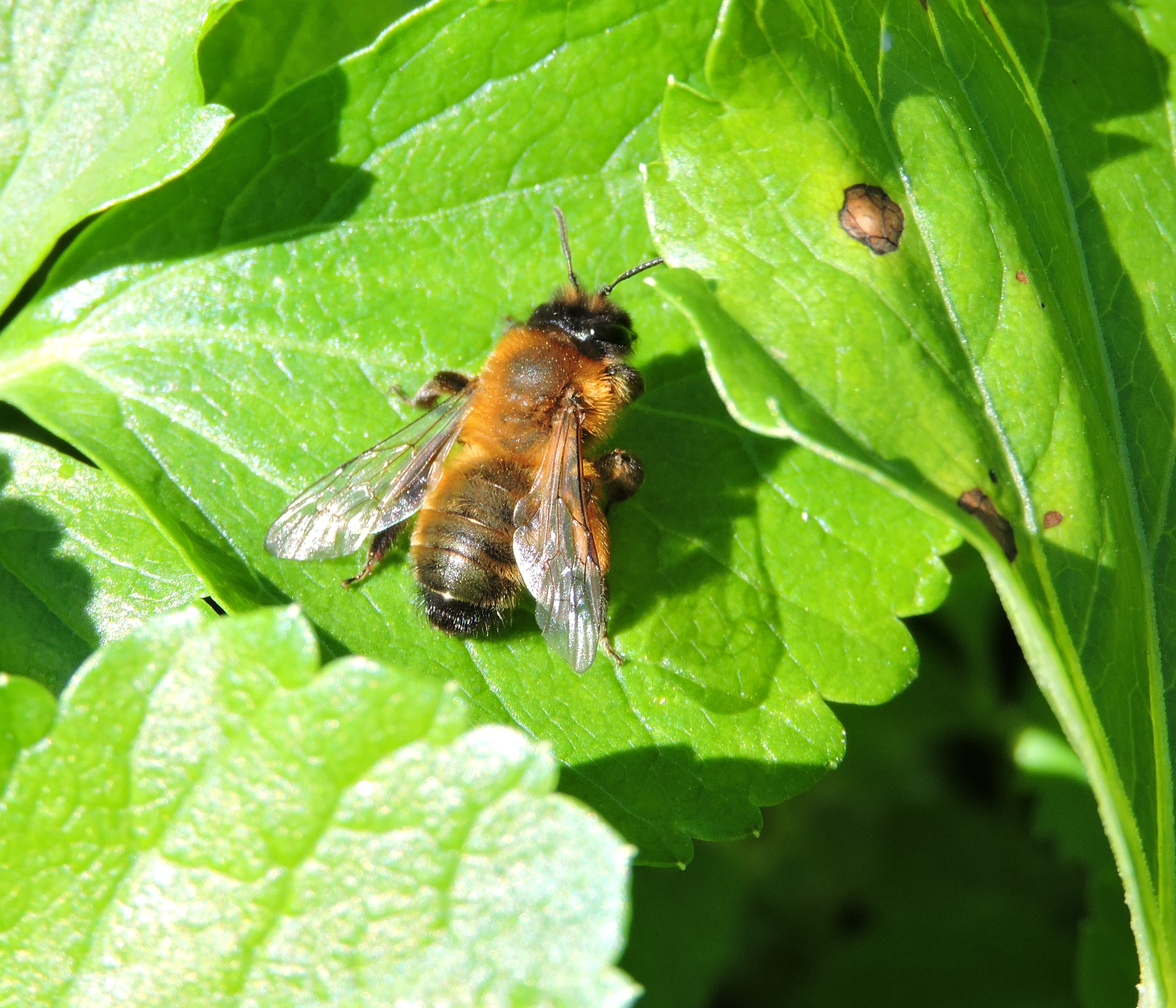
© Alan Keatley
Andrena nitida Grey-patched Mining Bee
© Alan Keatley
Andrena pilipes Black Mining Bee
A nationally rare bivoltine species heavily reliant on flowing shrubs such as
sallows and bramble.
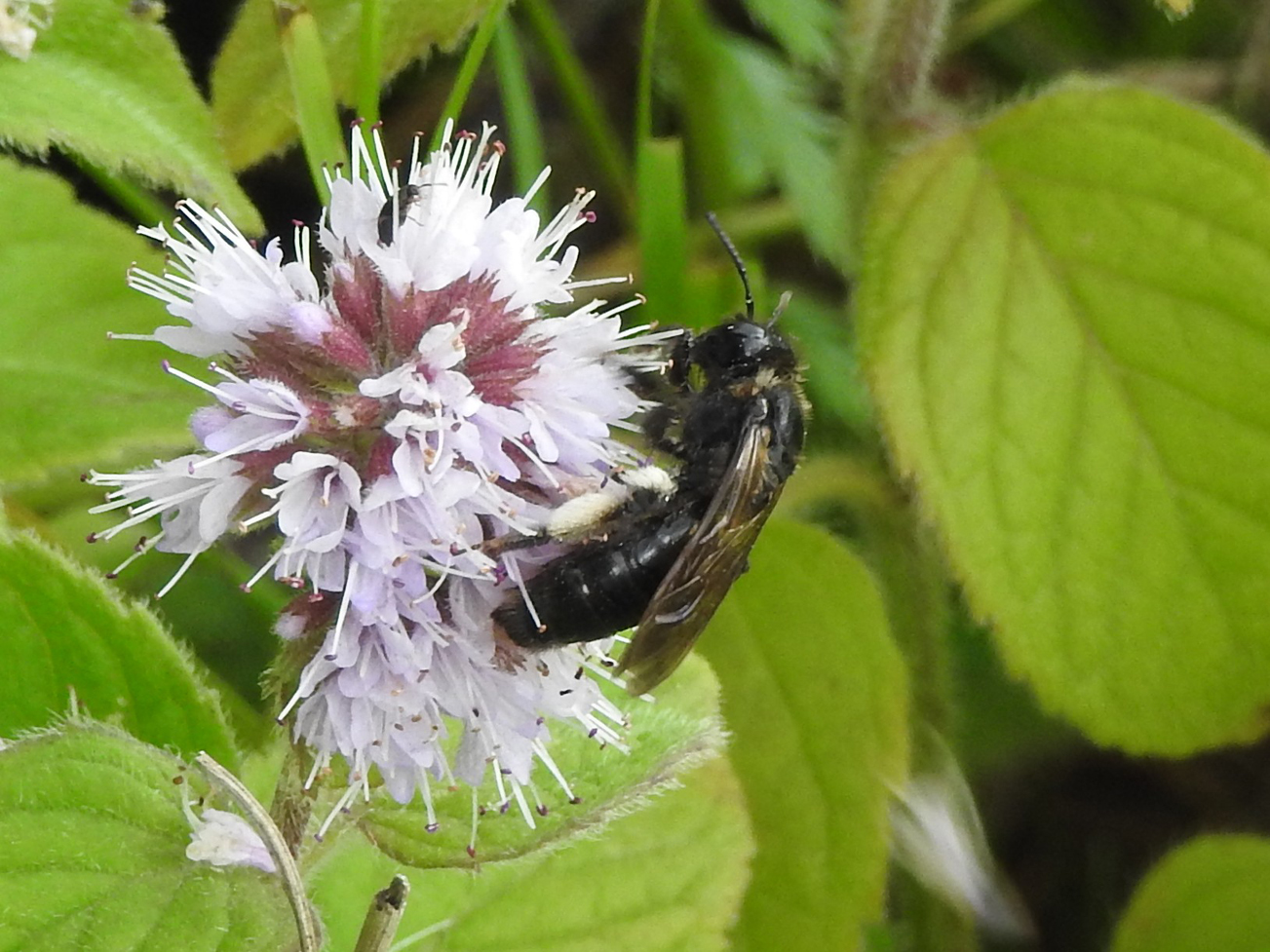
© Alan Keatley
Andrena scotica Chocolate Mining Bee
A spring flying species that emerges to coincide with blossoms of Blackthorn and
Hawthorn.
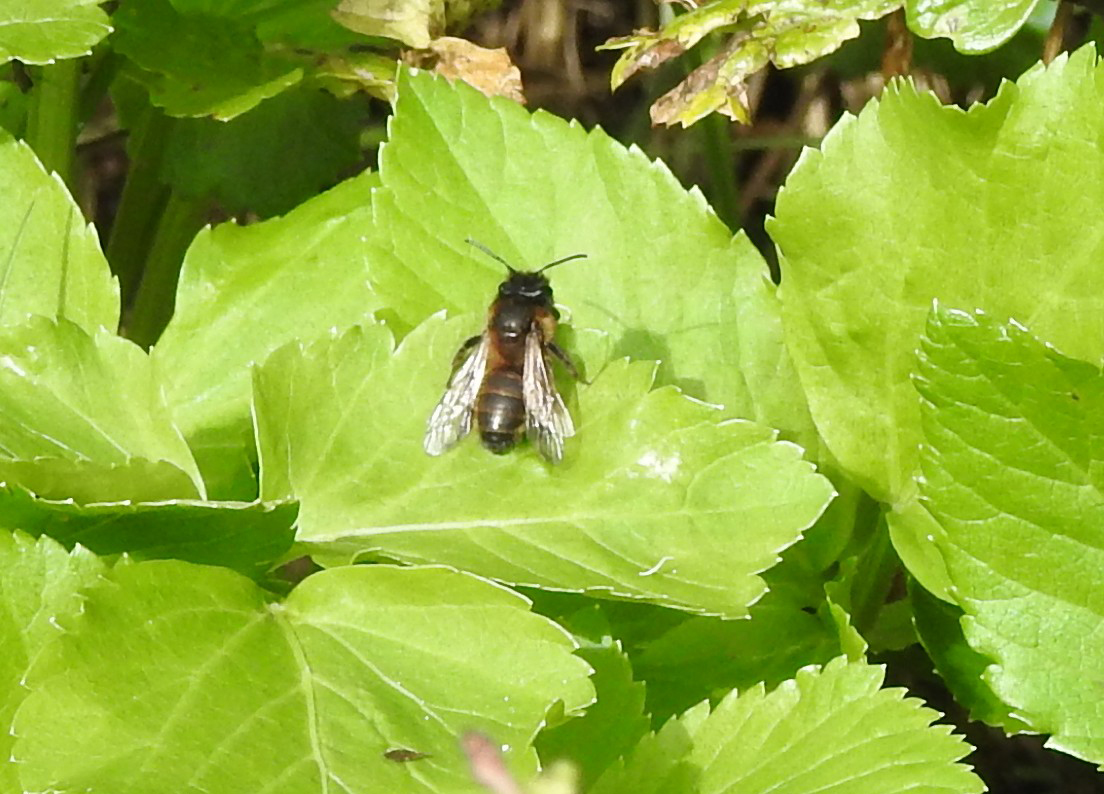
© Alan Keatley
Andrena trimmerana Trimmer’s
mining bee
First recorded in March 2020, but
possibly overlooked as closely resembles Chocolate mining bee, and shares same
scrubby habitat. Has reddish markings on sides of abdomen. Two generations.
© Alan Keatley
Halictus rubicundus
Orange-legged Furrow-bee
First recorded on site in September 2020 on ragwort and fleabane.
© Alan Keatley
Halictus tumulorum
Bronze Furrow-bee
Long flight season and can be seen on a
variety of flowers and shrubs. Likely common on site in flower meadows, but
overlooked.
© Alan Keatley
Lasioglossum calceatum
Common Furrow-bee
First recorded in September 2020. With records from the Maer, Exmouth,
this common and widespread species was clearly overlooked on site.
© Alan Keatley
Lasioglossum lativentre Furry-claspered Furrow-bee
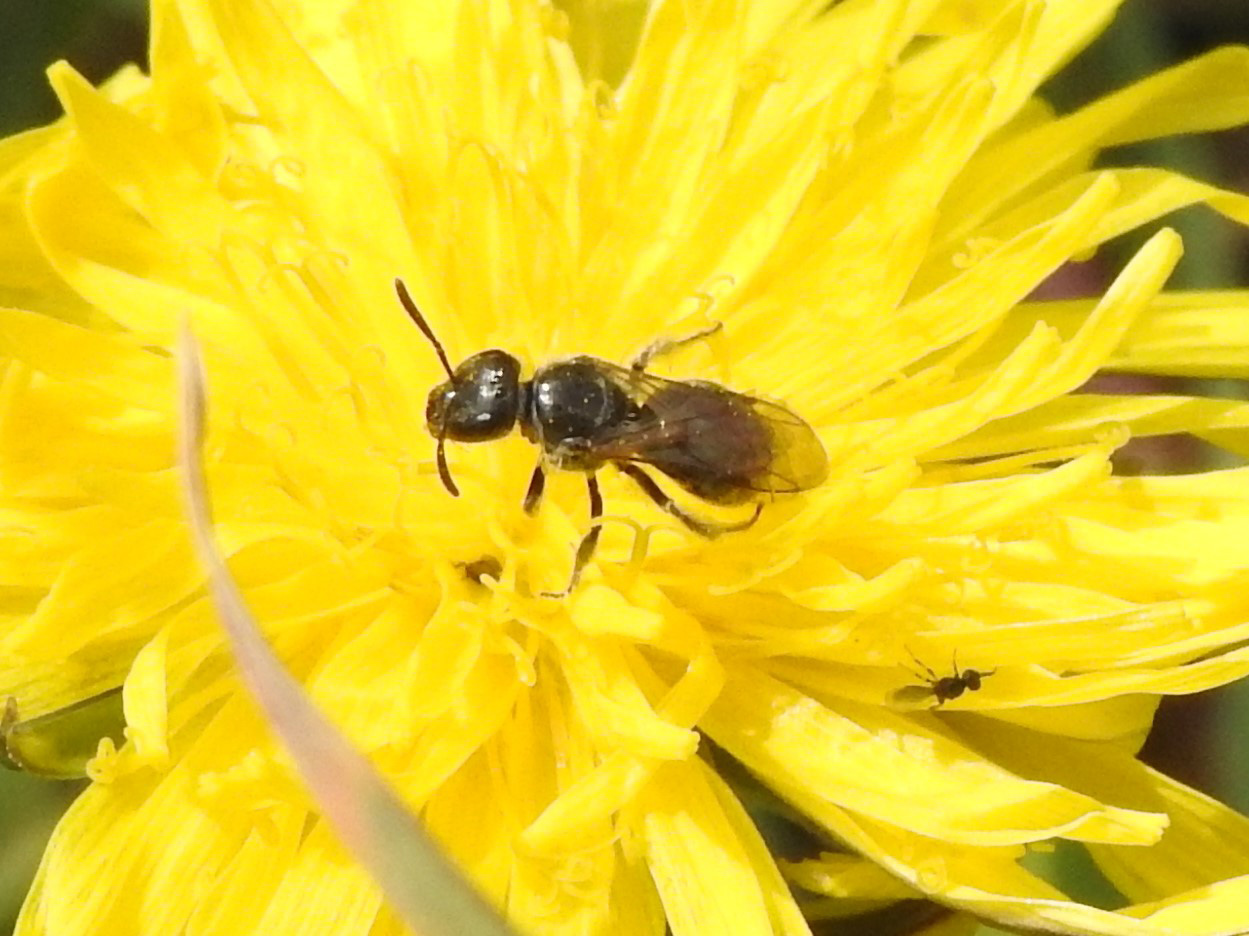
© Alan Keatley
Lasioglossum leucozonium White-zoned Furrow-bee
A common coastal dune species with long
flight season, found on a variety of flowers especially hawkbits and fleabane.
Males have white bases on hind tibia.
© Alan Keatley
Lasioglossum morio
Common Green Furrow-bee
A common and widespread species, first recorded in Apr 2021, presumably
previously overlooked.
© Alan Keatley
Lasioglossum pauperatum
Squat Furrow-bee
An RDB species last recorded before 1970.
Lasioglossum punctatissimum Long-faced Furrow-bee
First recorded in 2019.
© Alan Keatley
Sphecodes pellucidus
Sandpit Blood-bee
A cuckoo bee of Andrena barbilabris, one of only two Devon sites
© Alan Keatley
Sphecodes reticulatus
Reticulate Blood Bee
A Natonally Notable A cuckoo bee of several late flying Andrena species.
Hylaeus
communis Common Yellow-faced Bee
First recorded in June 2020, commonly found in various flowery
habitats, nesting in old plant stems and beetle holes in wood.
© Alan Keatley
Dasypoda hirtipes Pantaloon Bee
The female wears the trousers.
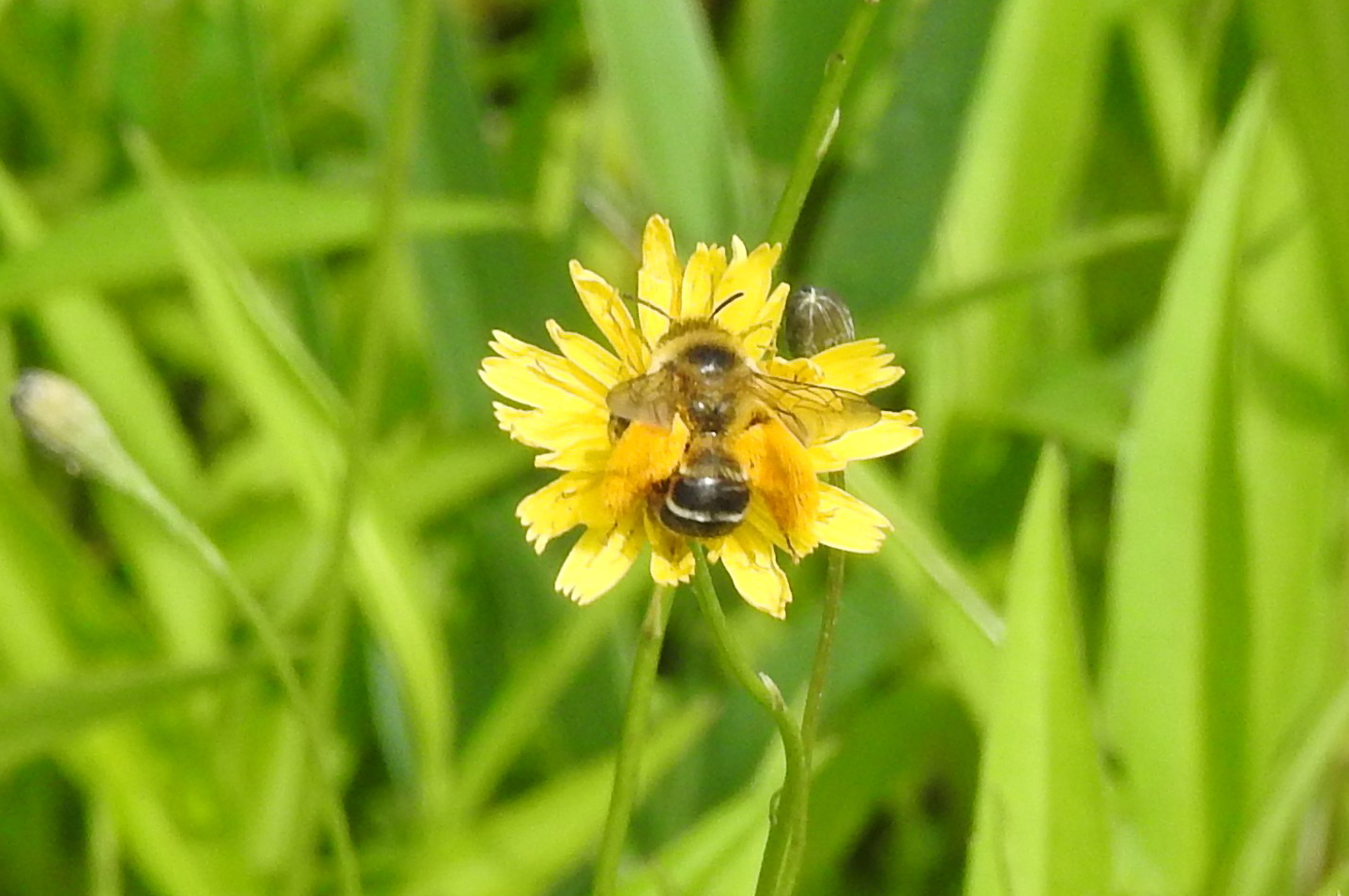
© Alan Keatley
Osmia bicornis Red
Mason Bee
A common resident of garden bee hotels, first recorded in 2019.
© Alan Keatley
Hoplitis claviventris Welted Lesser Mason Bee
Nests in plant stems such as Bramble and Rose.
Megachile leachella
Silvery Leafcutter Bee
A Nationally Notable B species often found in numbers along the Dune Ridge.
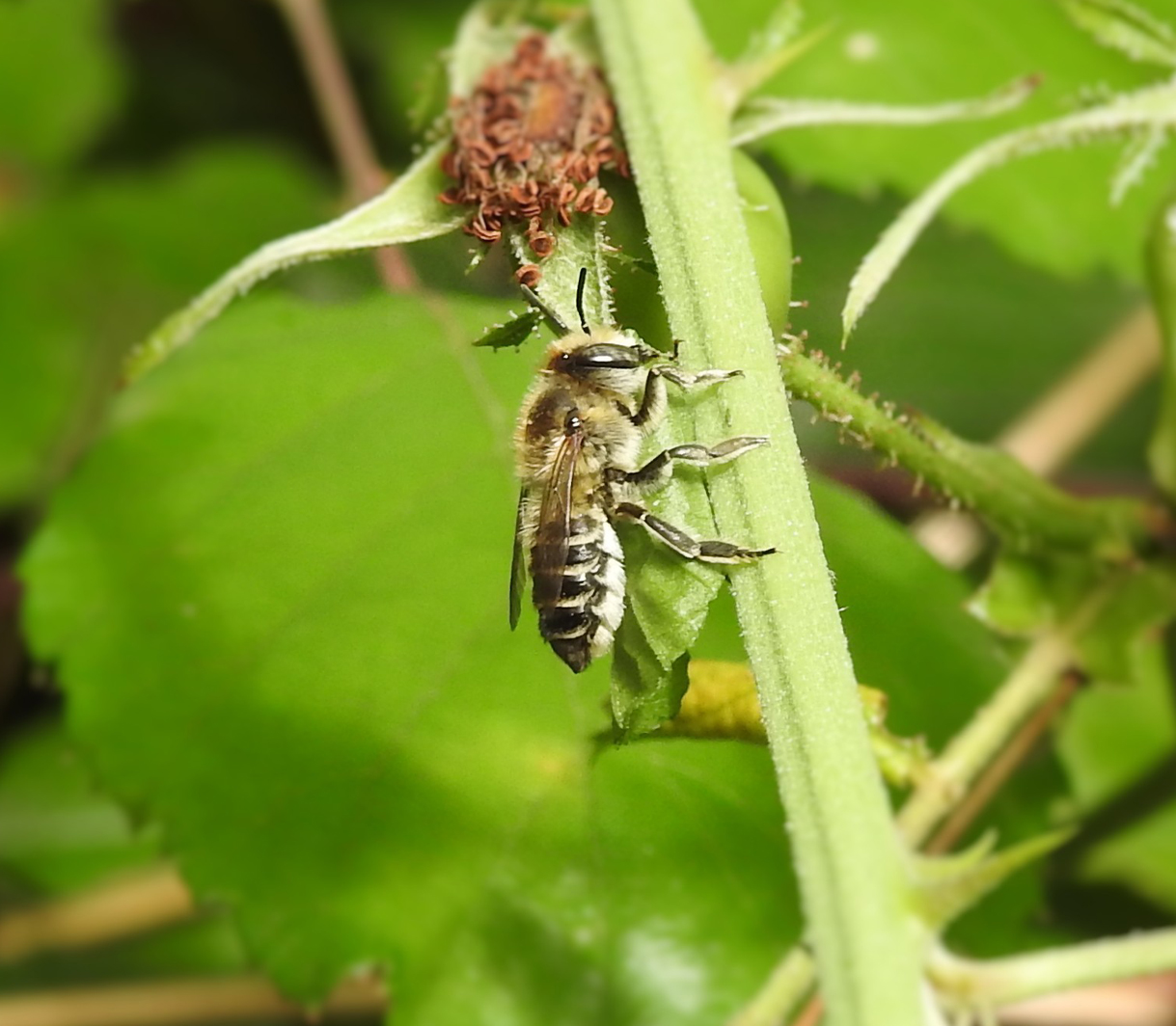
© Alan Keatley
Megachile maritima
Coast Leafcutter Bee
Can be seen in numbers around Wryneck Plain and the Dune Ridge.
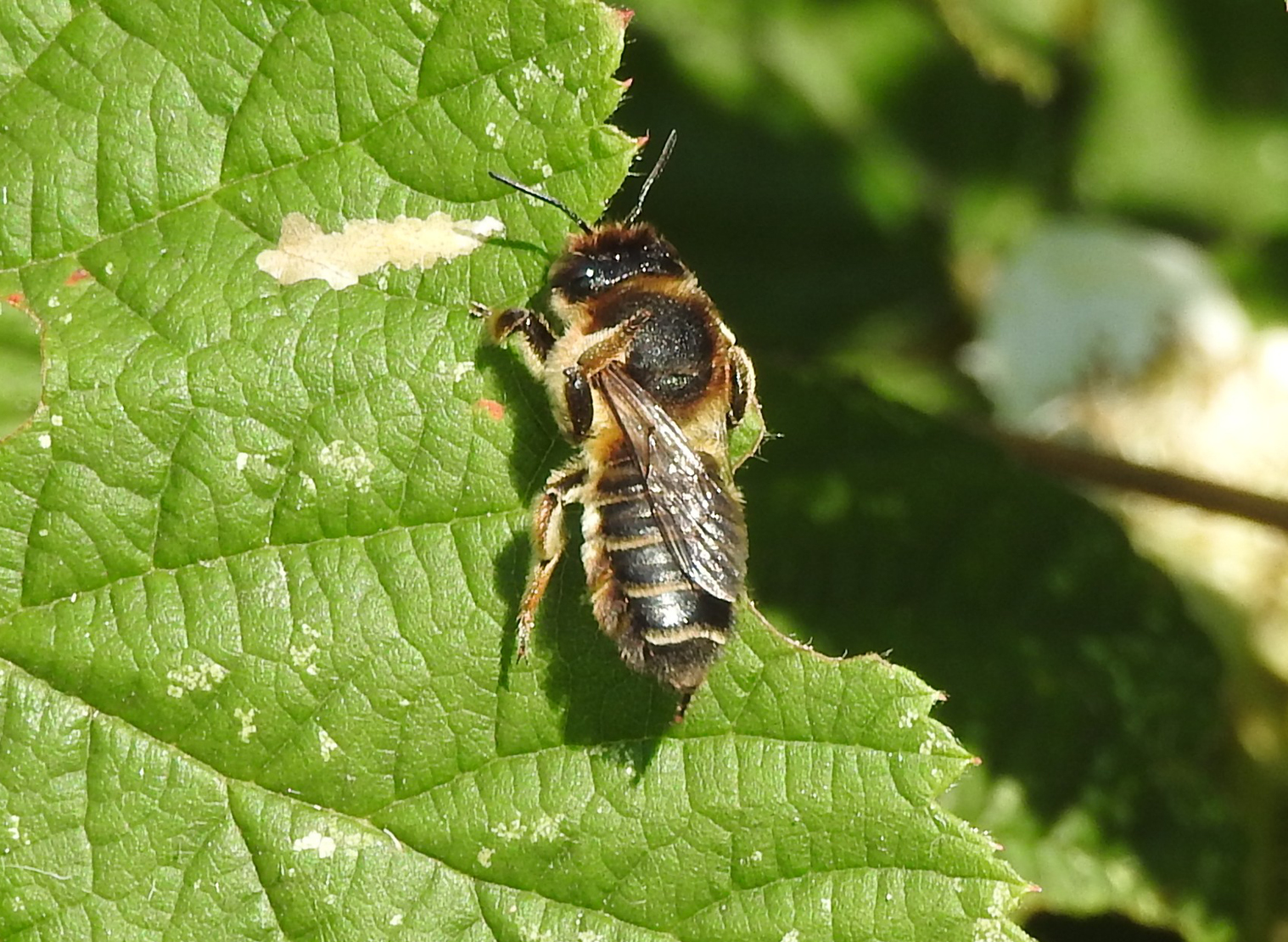
© Alan Keatley
Megachile versicolor Brown-footed Leafcutter Bee
A Summer species of flower meadows. Widespread in southern England . First recorded on site was in early September 2019, but possibly overlooked amongst commoner Silvery Leafcutter Bee.
© Alan Keatley
Coelioxys conoidea
Large Sharp-tailed Bee
A cuckoo bee of Megachile maritima.
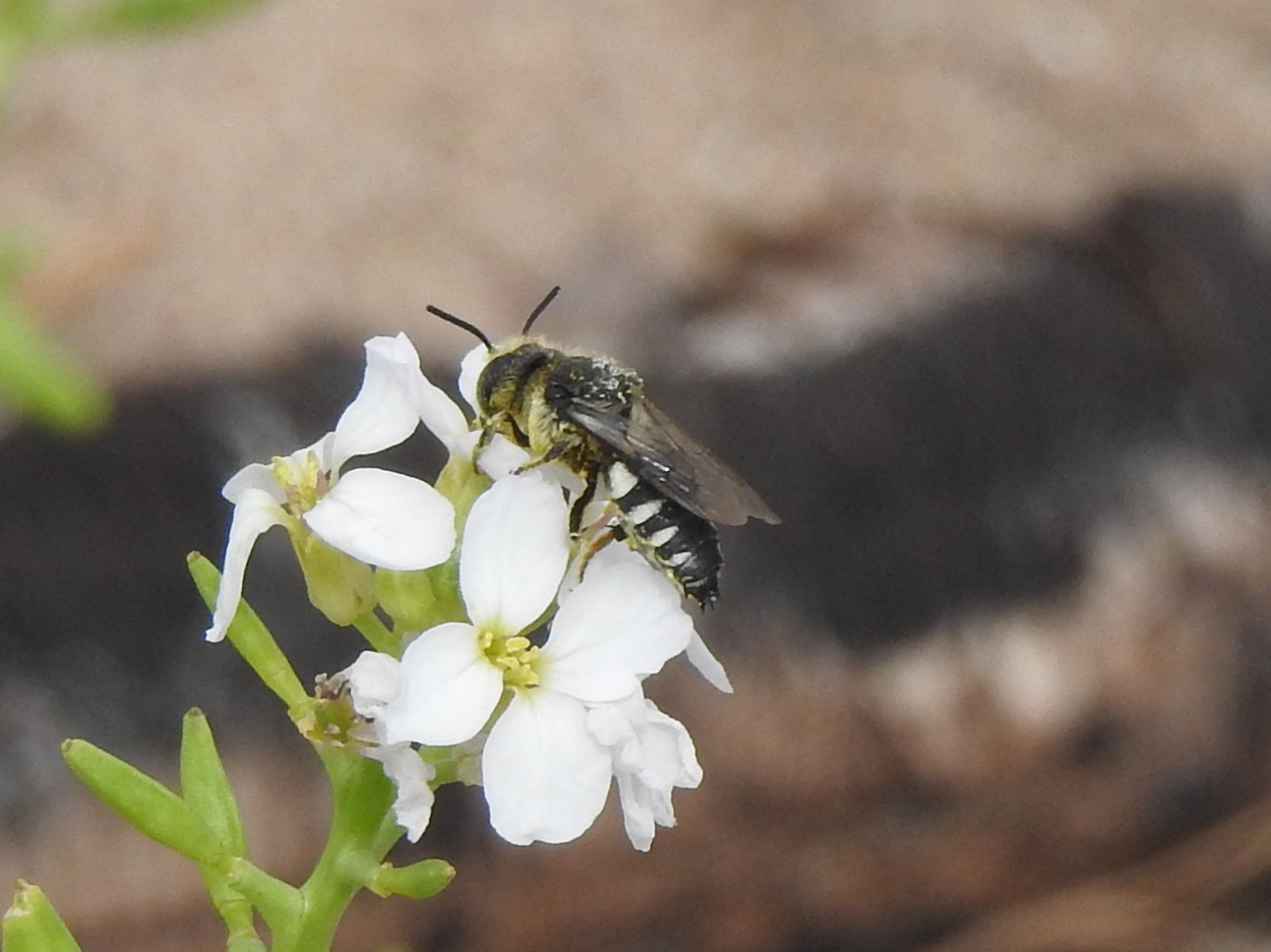
© Alan Keatley
Nomada fucata Painted Nomad Bee
A Cuckoo bee of Andrena flavipes.
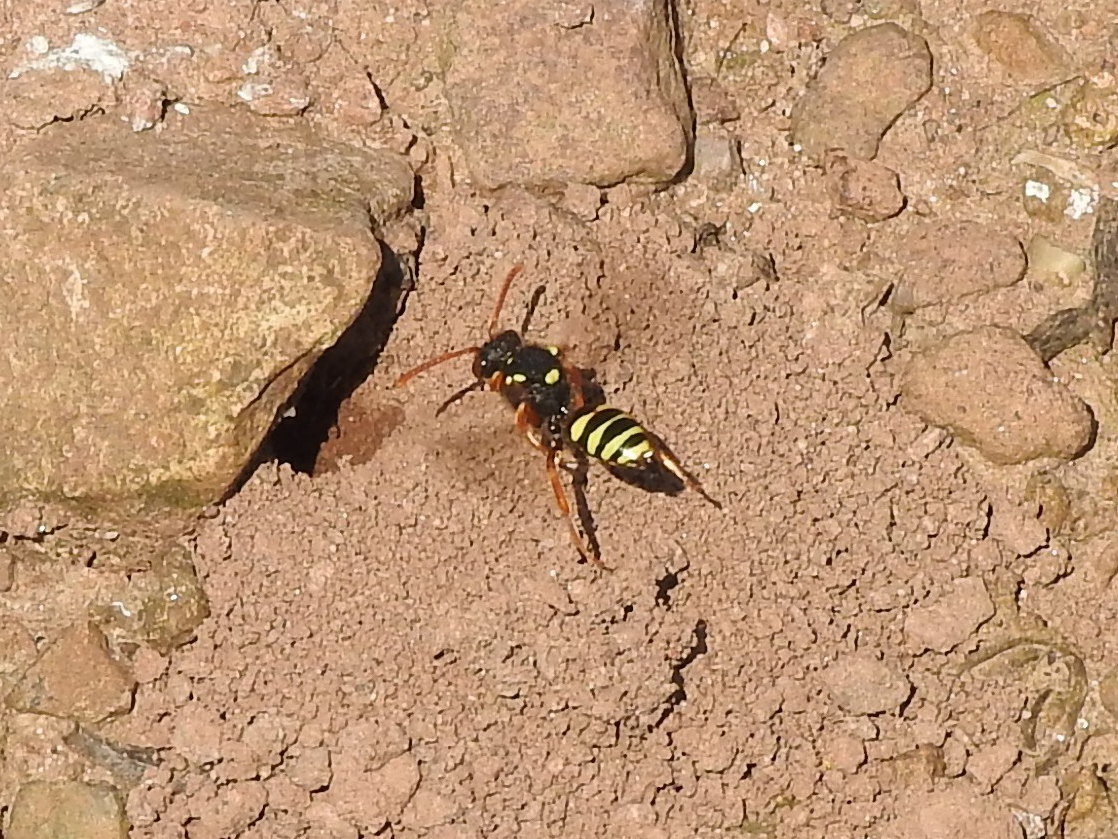
© Alan Keatley
Nomada goodeniana Gooden's Nomad Bee
A Cuckoo bee of Andrena nigroaenea. First recorded in 2018.
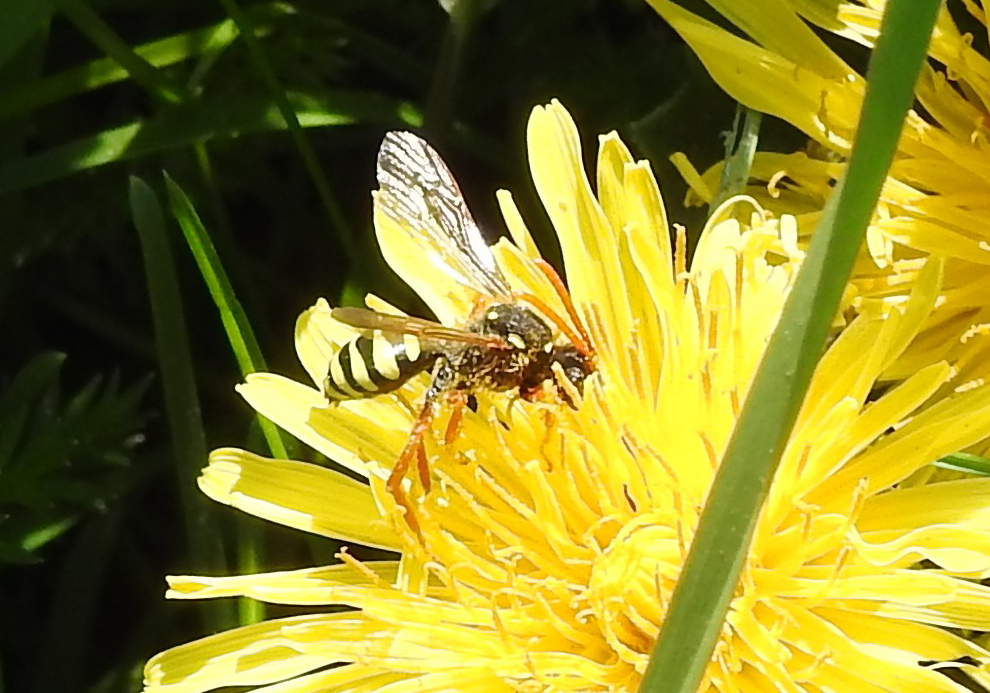
© Alan Keatley
Nomada marshamella Marsham's Nomad Bee
A Cuckoo bee of Andrena nigroaenea.
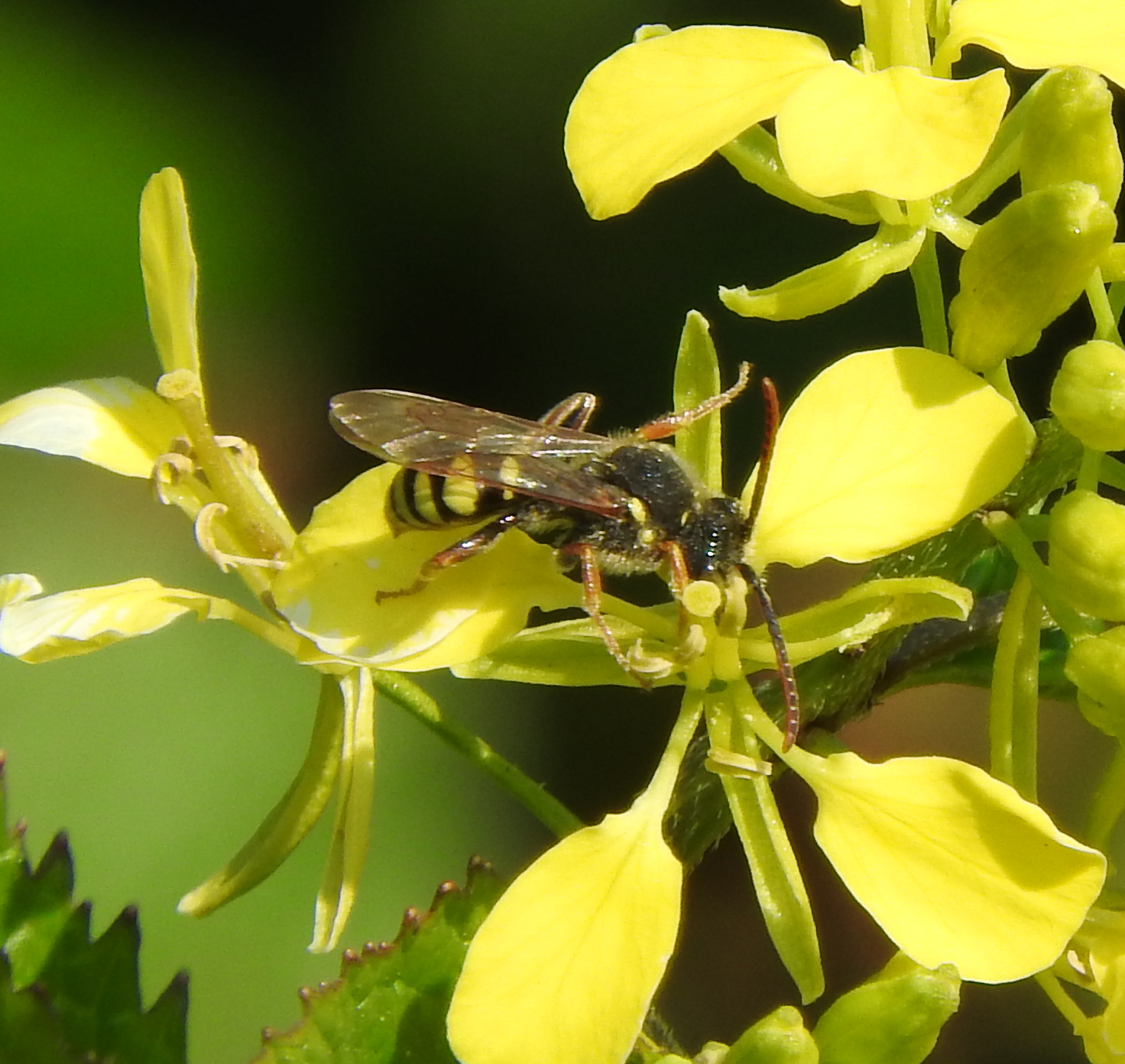
Nomada ruficornis
Fork-jawed Nomad Bee
A Cuckoo bee of Andrena haemorrhoa
first recorded in 2019.
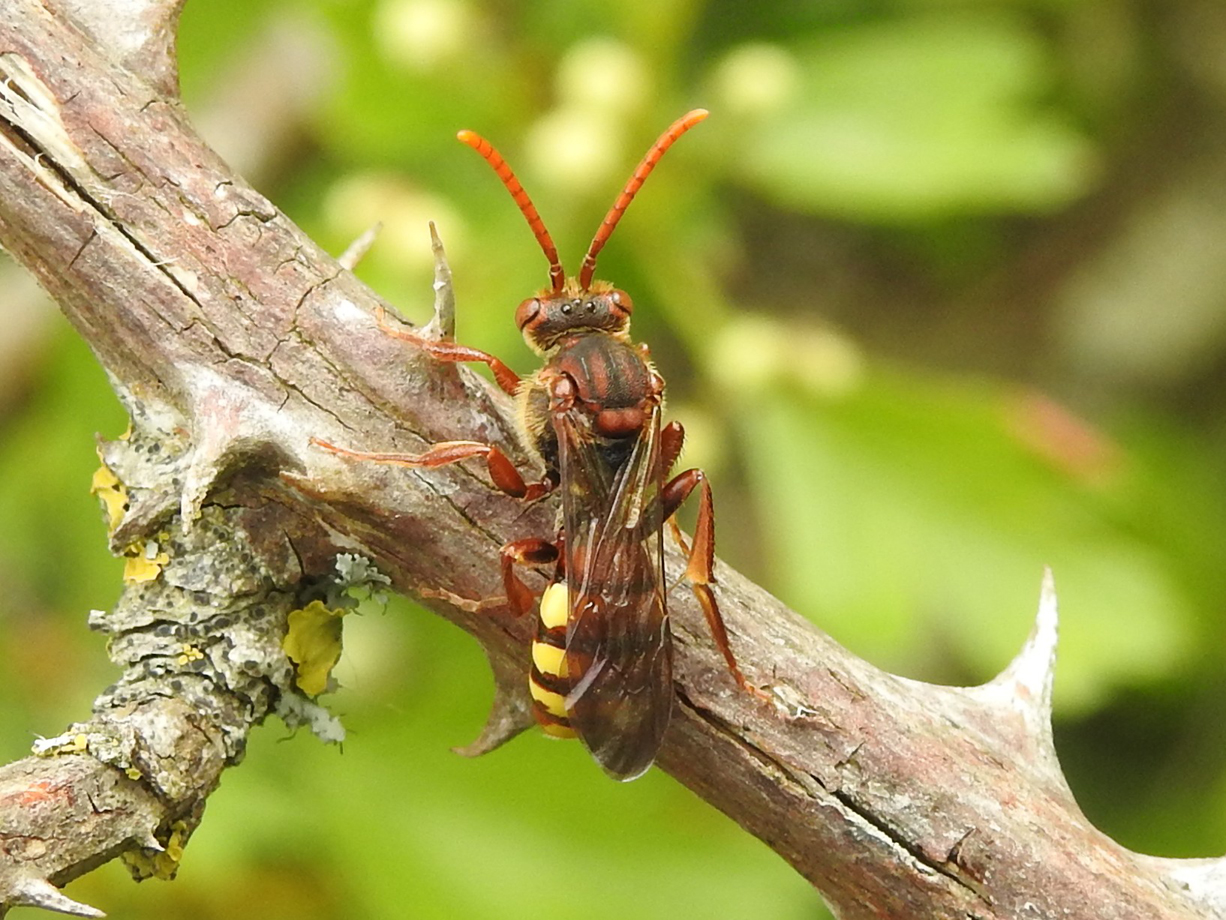
© Alan Keatley
Epeolus variegatus Black-thighed Cuckoo bee
A Cuckoo bee of Colletes fodiens.
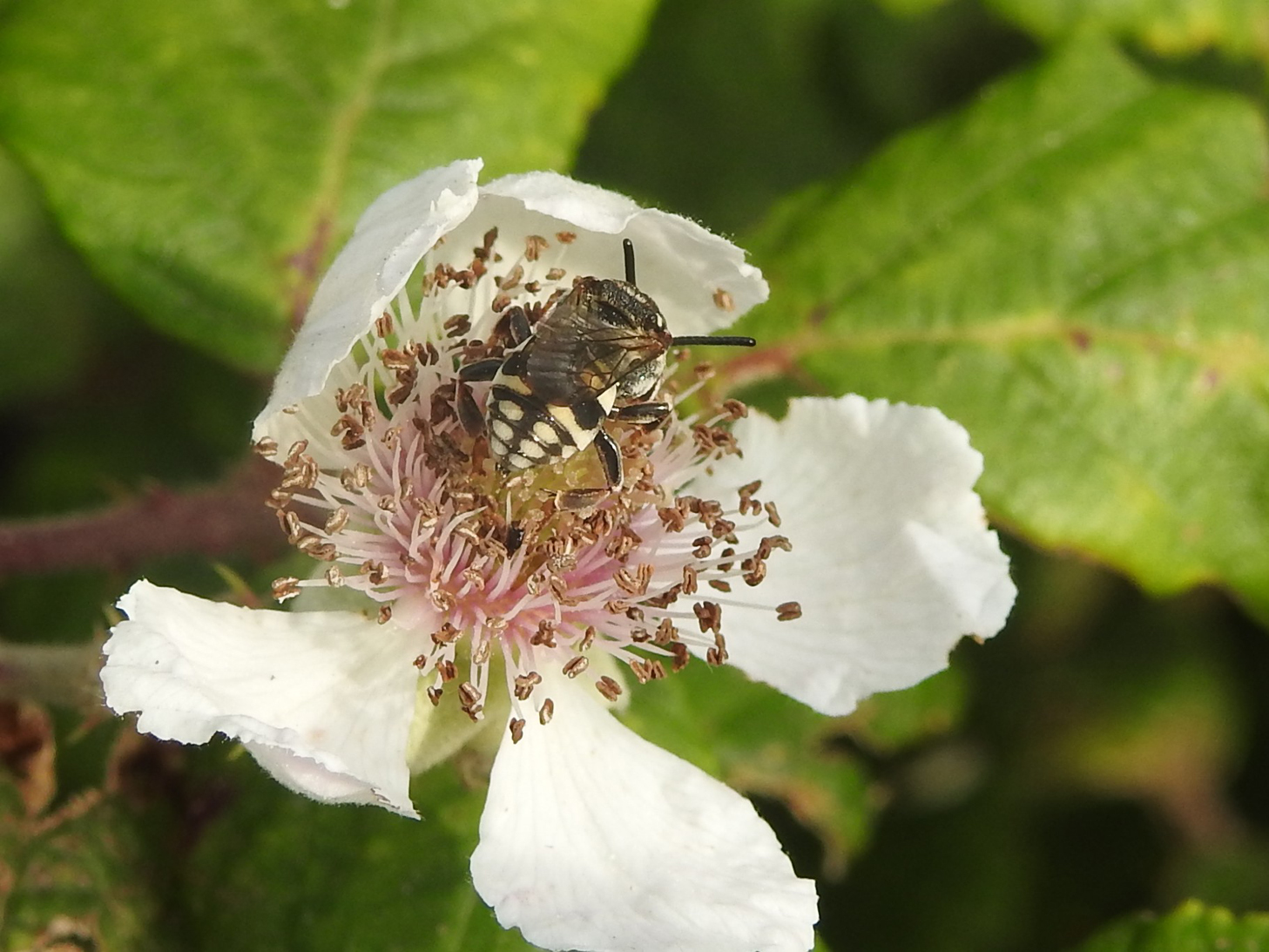
© Alan Keatley
Eucera longicornis
Long-horned Bee
A declining Nationally Notable A species. A male was recorded in the Back Meadow
in June 2018, this suggests an undiscovered colony nearby as the closest recent
sites are in Torbay and on the Undercliff.
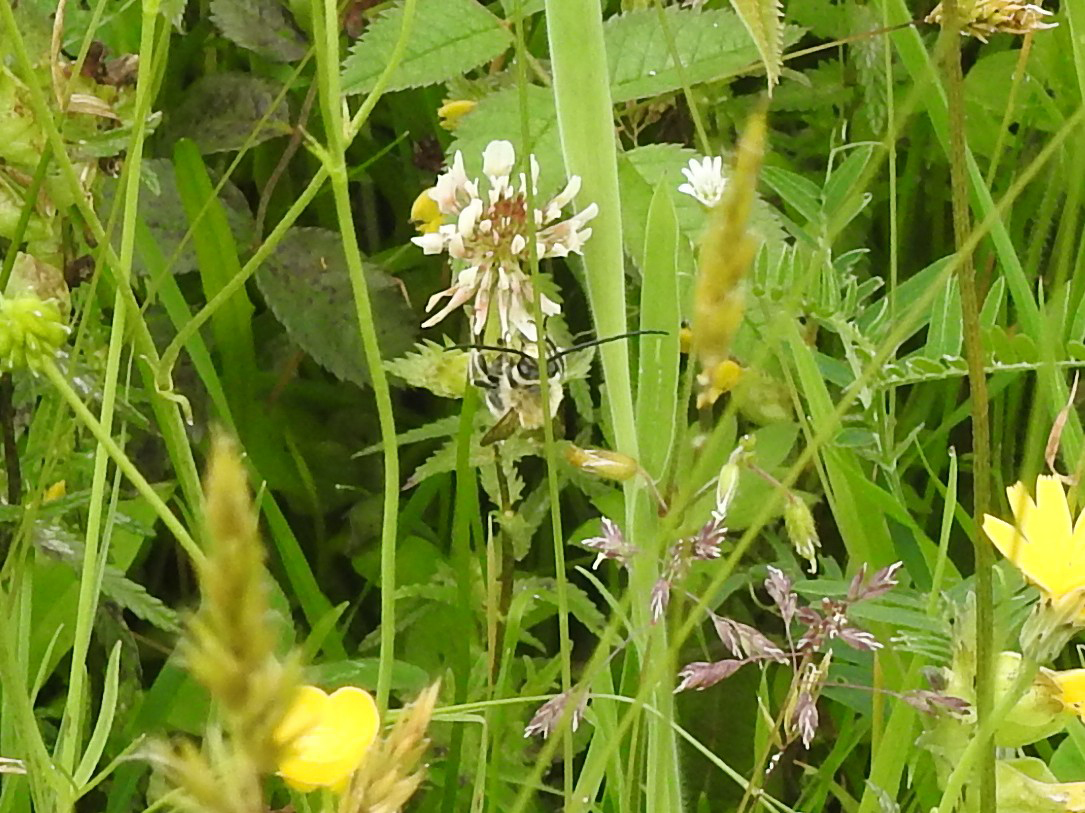
© Alan Keatley
Anthophora bimaculata
Little (Green-eyed) Flower-bee
The shrill hum and green eyes of the male can be seen and heard along the Dune
Ridge.
© Alan Keatley
Anthophora plumipes
Hairy-footed Flower Bee
A widespread species however the first record was not until 2019.
© Alan Keatley
Bombus hypnorum Tree
Bumblebee
First recorded in the UK in 2001, this species is now distributed over almost
all of England but the first here wasn't until 2017, although as nests were
observed at least two queens must have been present in 2016.
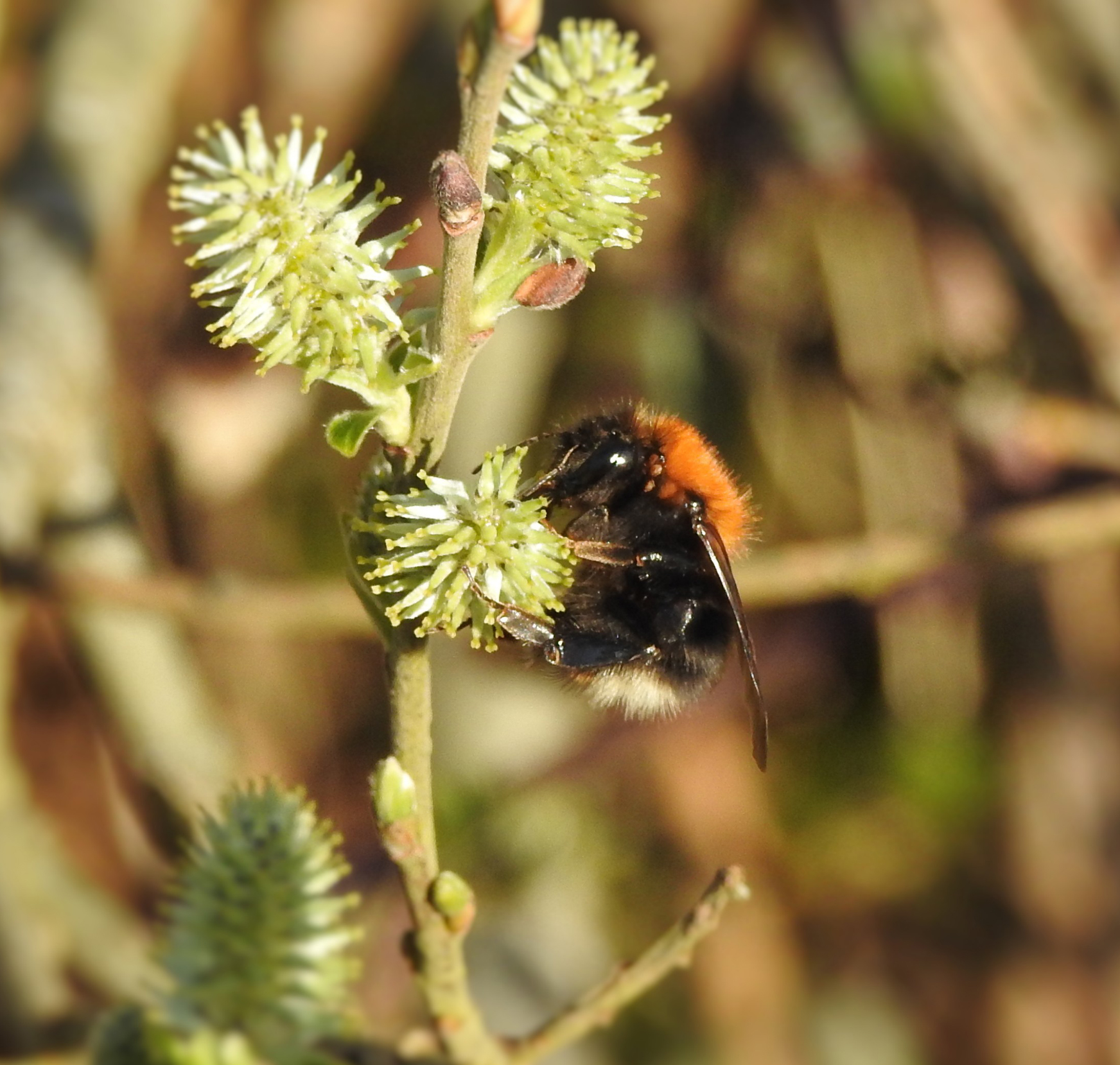
© Alan Keatley
Bombus jonellus Heath Bumblebee
Rediscovered on site in 2017 it remains in low numbers with no records at all in
2019.
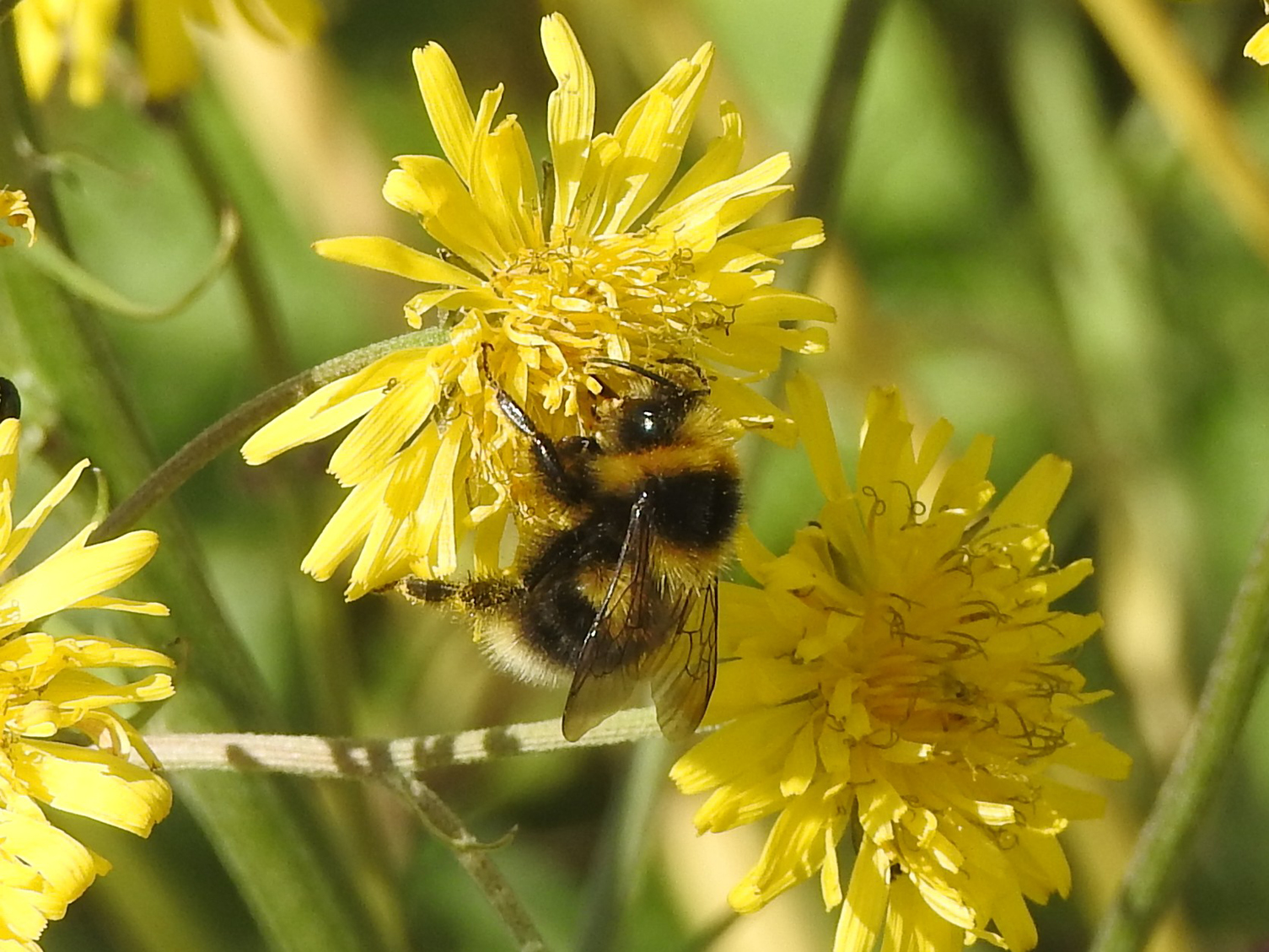
© Alan Keatley
Bombus lapidarius
Red-tailed Bumblebee
One of the more regular species recorded on site.
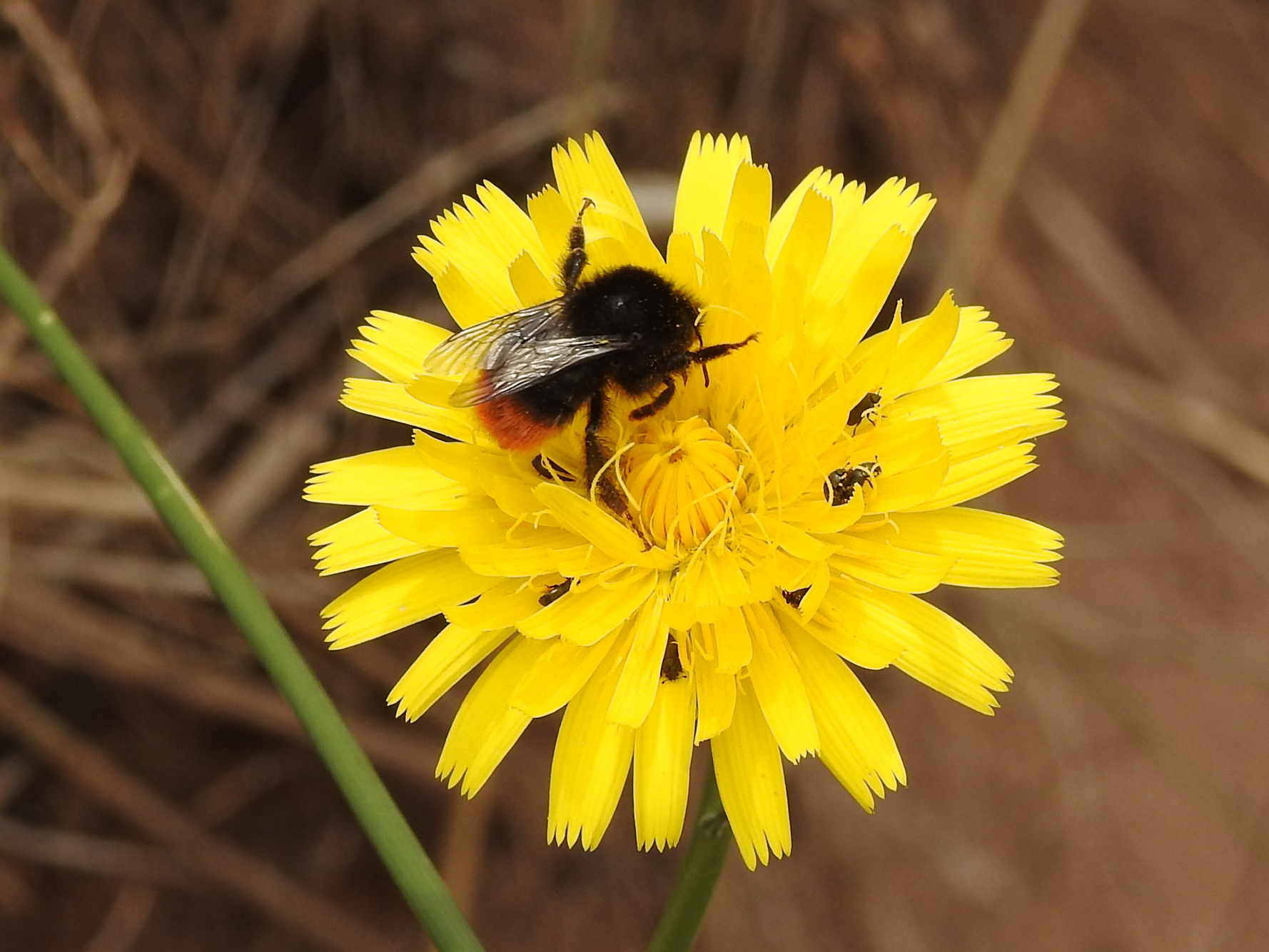
© Alan Keatley
Bombus leucorum White-tailed Bumblebee
Now known to be a complex of three species, no DNA studies have been carried out
on site but visual checks suggest this species.
Bombus pascuorum Common Carder-bee
Widespread, any brown species of bumblebee on site will be this species.
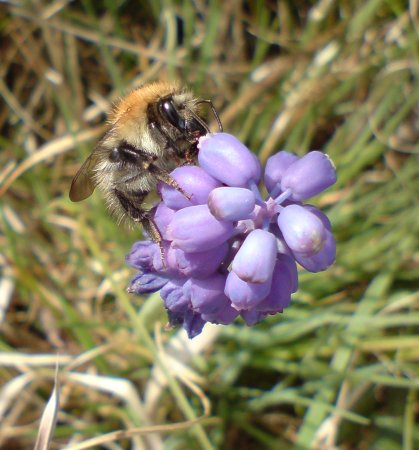
Bombus pratorum Early Bumblebee
A common species around flowering bramble and apple trees on site.
Bombus sylvestris Forest Cuckoo Bumblebee
A cuckoo be of Bombus pratorum.
Bombus terrestris Buff-tailed Bumblebee
The commonest species on site. Recent years have seen winter active nests around
the Amusements.
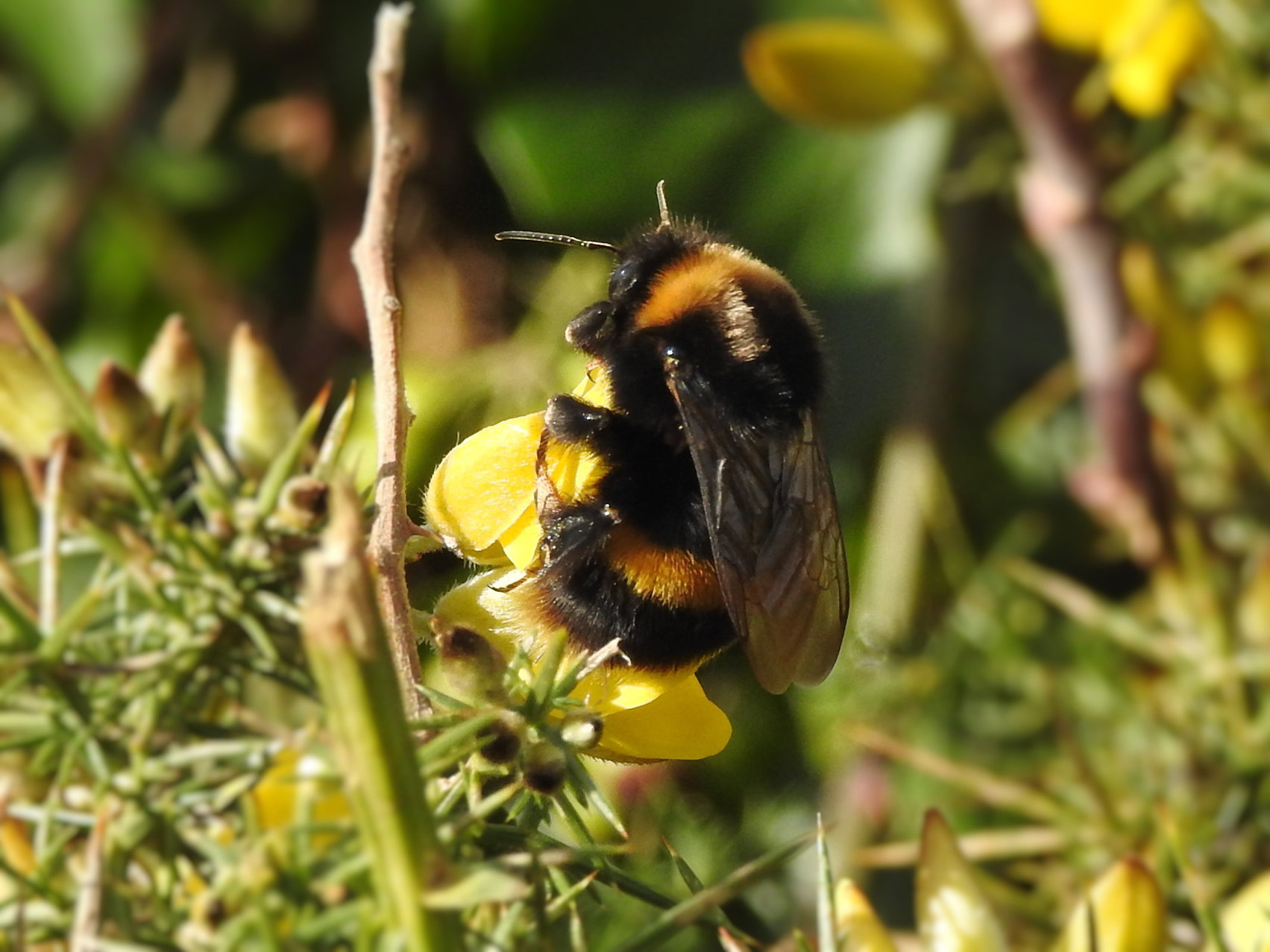
© Alan Keatley
Bombus vestalis Southern Cuckoo Bumblebee
A cuckoo bee on Bombus terrestris.
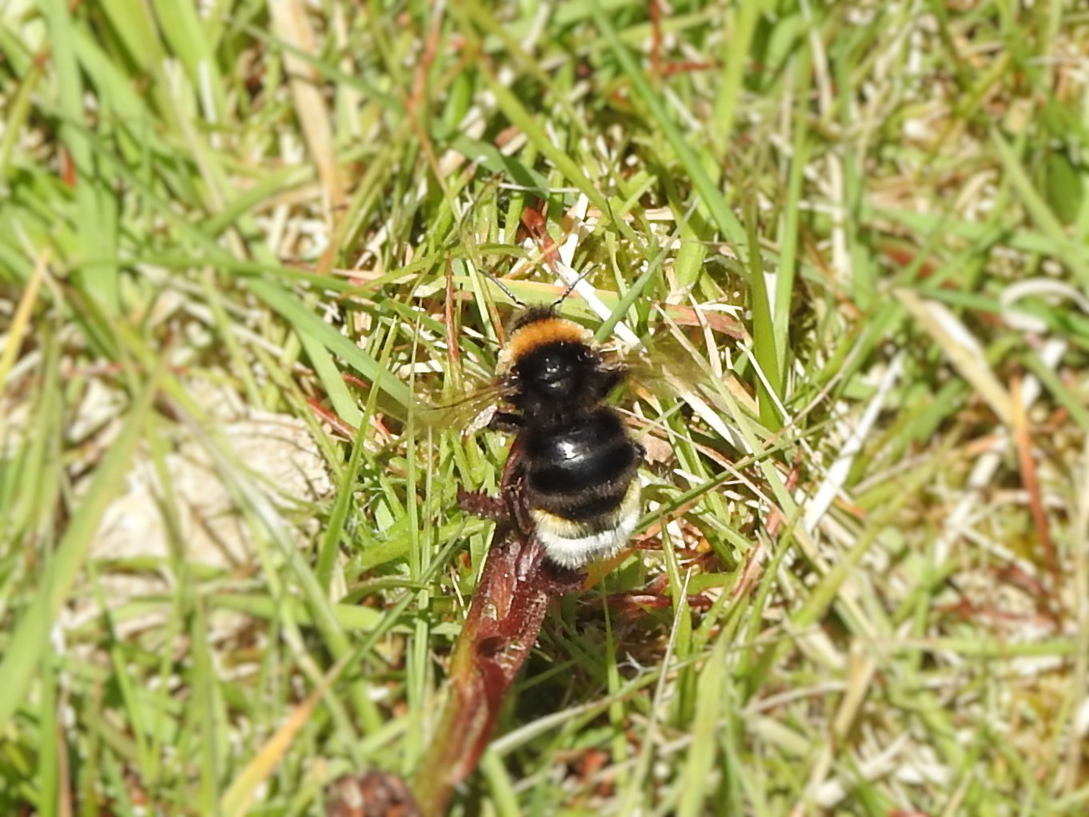
© Alan Keatley
Apis mellifera Honey
Bee
No hives are kept on site, so those seen come from feral populations. The main
prey of the Bee-wolf Philanthus triangulum.
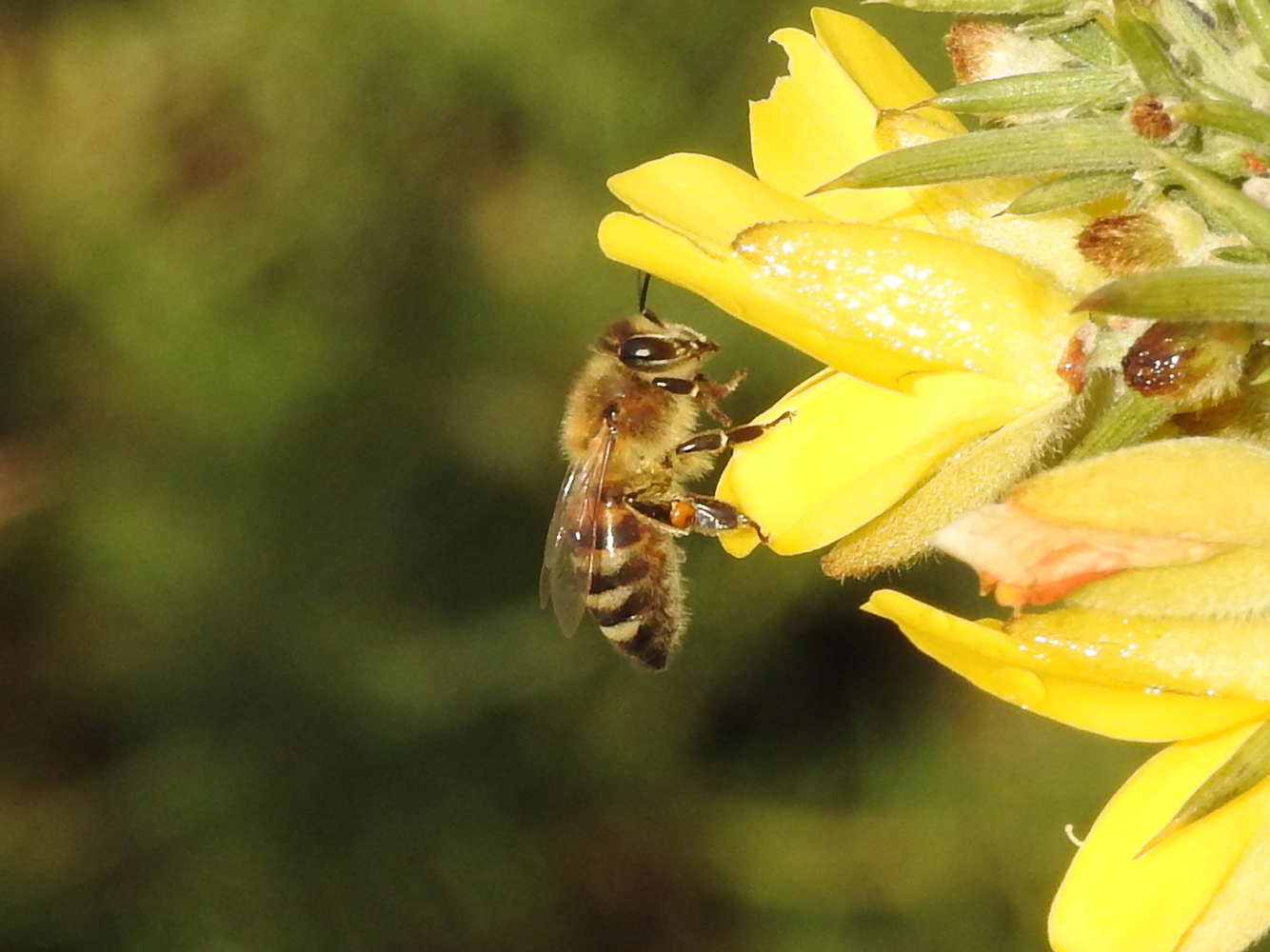
© Alan Keatley